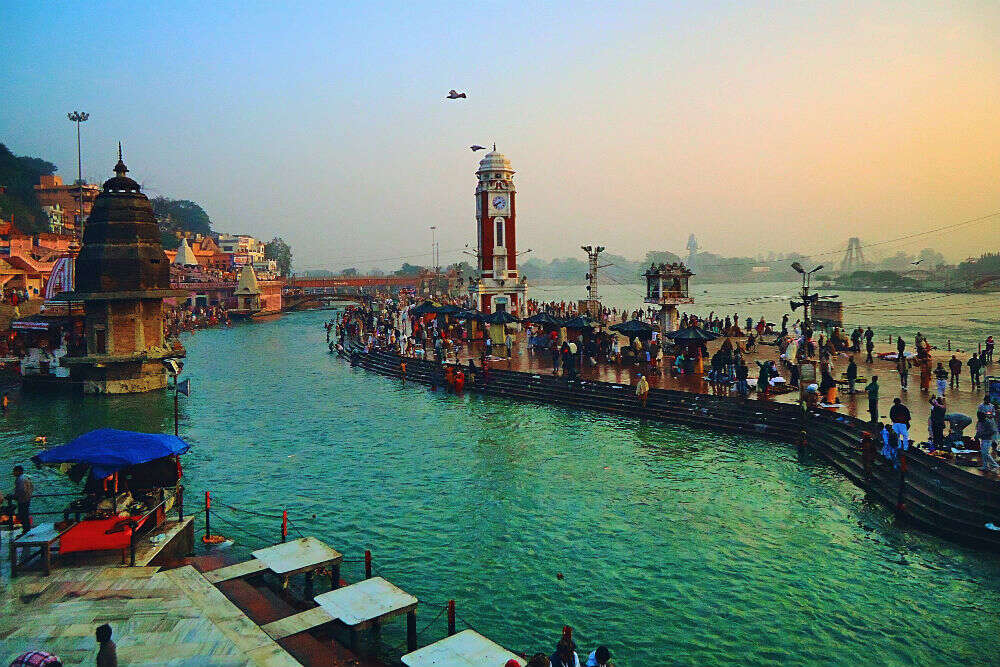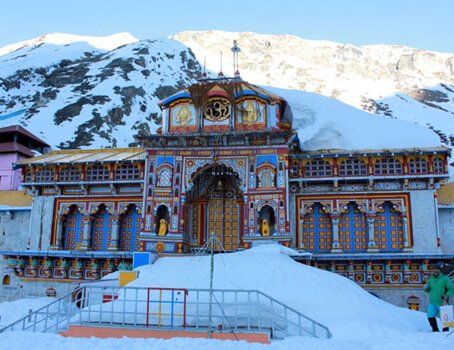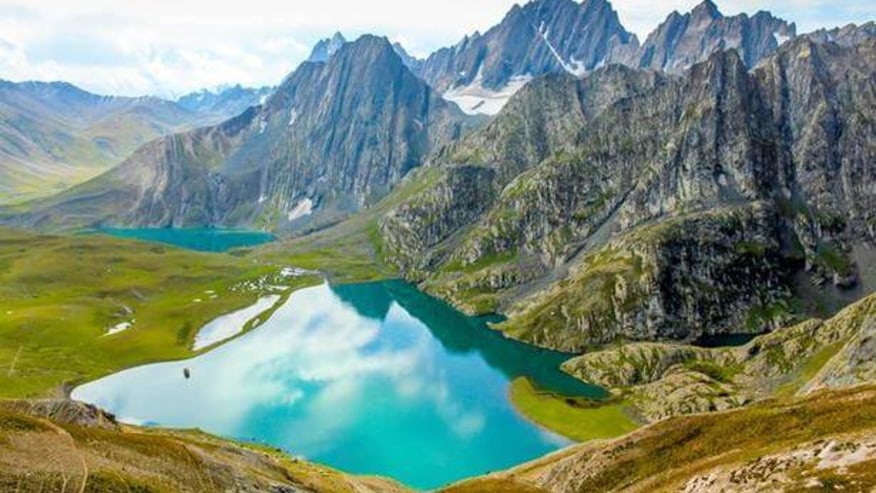JOURNEY TO BRAMHAKUND, SATOPANTH SWARG ROHINI MARG AND VAIKUNTH BHUMI
Haridwar, also spelled Hardwar, is a city and municipality in the Haridwar district of Uttarakhand, India. With a population of 228,832 in 2011, it is the second largest city in the state and the largest in the district.The city is situated on the right bank of the Ganga river, at the foothills of the Shivalik ranges. Haridwar is regarded as a holy place for Hindus, hosting important religious events and serving as a gateway to several prominent places of worship. Most significant of the events is the Kumbha Mela, which is celebrated every 12 years in Haridwar. During the Haridwar Kumbh Mela, millions of pilgrims, devotees, and tourists congregate in Haridwar to perform ritualistic bathing on the banks of the river Ganges to wash away their sins to attain Moksha.
 |
| HAR KI PAURI |
According to the Samudra manthan, Haridwar along with Ujjain, Nashik and Prayagraj (Allahabad) is one of four sites where drops of Amrit, the elixir of immortality, accidentally spilled over from the pitcher while being carried by the celestial bird Garuda. Brahma Kund, the spot where the Amrit fell, is located at Har ki Pauri (literally, "footsteps of the Lord") and is considered to be the most sacred ghat of Haridwar. It is also the primary centre of the Kanwar pilgrimage, in which millions of participants gather sacred water from the Ganga and carry it across hundreds of miles to dispense as offerings in Śiva shrines. Today, the city is developing beyond its religious importance, with the fast developing industrial estate of State Industrial Development Corporation of Uttarakhand (SIDCUL), and the close by township of Bharat Heavy Electricals Limited as well as its affiliated ancillaries.
Haridwar presents a kaleidoscope of Indian culture and development. In the sacred writings, it has been differently specified as Kapilsthan, Gangadwar, and Mayapuri. It is additionally a passage for the Chota Char Dham (the four principal pilgrim destinations in Uttarakhand viz, Badrinath, Kedarnath, Gangotri, and Yamunotri), subsequently, Shaivaites (adherents of Lord Shiva) and Vaishnavites (devotees of Lord Vishnu) call this place Hardwar and Haridwar individually, relating to Har being Shiv and Hari being Vishnu.
SATOPANTH SWARG ROHINI
It's fascinating just to watch the devout locals talk about this journey that Sadhus and other devotees take during the months of June to August. The locals call this journey to Satopanth , a journey along the path of Satya Path or the way of Truth. Another play of words that describe this journey is based on the name Swargarohini which means a path to heaven. It has been believed by devout Hindus that this is the only way to reach heaven with human body.The Sadhus embark on this journey after an elaborate prayer service at the Badrinath temple. 4 kms from Badrinath town, the village of Mana is the last inhabited village on this trail. On the way there are several stopovers like the Nag-Nagini Temple, Bhrigu Gufa and Mata Moorthi Mandir, a temple dedicated to the wife of Dharma. Ahead on the trail along the Alaknanda, comes Anandvan, the meadow of joy aptly name so because of scenic beauty of the spot. Vasudhara Falls is just a short distance away from Anandvan. Among the several myths about pitstops on this trail, there's an interesting one about Vasudhara. It is believed that the water here does not fall on sinners.
Then comes Lakshmi Van, a spot where numerous birch trees can be found and in the olden days the bark of the tree was used to write manuscripts on. Legend has it that Nakul died at Lakshmi Van during the journey of Pandavas in this region. Lakshmi Van is also the first pitstop for travellers on this trail.Not too far away from Lakshmi Van is Sahastra Dhara, the spectacular multiple waterfalls on a granite ridge. It is also believed that another Pandava brother Sehdev died here. The Sadhus often tell about the narrow ridges they have to cross after Sahastra Dhara. At the same time the view around gets more breathtaking. If we geographically place the location on the map, the view is that of the back side of Kedarnath. The next pitstop on the journey is Chakrateerth Caves but those who can they do walk ahead because not too far from there is Satopanth Lake where Bheem fell. In the summer months of the year there are huts of Sadhus where visitors spend the night. Others find caves or camp on flat grounds. After spending a day at the Lake, they proceed ahead to the Swargarohini Glacier via Chandra Kund and Surya Kund. It is believed that there are seven steps to heaven at this glacier. However, not more than three are visible at a time due to snow and fog.
VAIKUNTH BHUMI [BADRINATH]
Badrinath is a holy town and a nagar panchayat in Chamoli district in the state of Uttarakhand, India. It is one of the four sites in India's Char Dham pilgrimage and gets its name from the temple of Badrinath.Badri refers to a berry that was apparently said to grow abundantly in the area, and nath means "Lord" / "Lord of" as per context in which it is referred. Badri is also the Sanskrit name for the Indian Jujube tree, which has an edible berry. Some scriptural references refer to Jujube trees being abundant in Badrinath.
According to the Bhagavata Purana, "There in Badrikashram, the supreme being (Vishnu), in his incarnation as the sages Nara and Narayana, had been undergoing great penance since time immemorial for the welfare of all living entities."The Badrinath area is referred to as Badari or Badarikaashram in Hindu scriptures. It is a place sacred to Vishnu, particularly in Vishnu's dual form of Nara-Narayana. Thus, in the Mahabharata, Krishna, addressing Arjuna, says, "Thou wast Nara in a former body, and, with Narayana for thy companion, didst perform dreadful austerity at Badari for many myriads of years."

One legend has it that when the goddess Ganga was requested to descend to earth to help suffering humanity on the request of Suryavanshi king Bhagiratha, the earth was unable to withstand the force of her descent. Therefore, the mighty Ganga was split into two holy channels, with Alaknanda one of them.
Another legend explains both name and sitting posture as this place was full of Badri bushes and Vishnu meditating for, beloved Lakshmi stood next to him sheltering him from scorching sunlight turned into a Badri herself called 'BADRI VISHAL' and her lord (Nath) became the BadriNath.
The mountains around Badrinath are mentioned in the Mahabharata, when the Pandavas were said to have expired one by one, when ascending the slopes of a peak in western Garhwal called Swargarohini (literal meaning - the 'Ascent to Heaven'). The Pandavas passed through Badrinath and the town of Mana, 4 km north of Badrinath, on their way to Swarg (heaven). There is also a cave in Mana where Vyasa, according to legend, wrote the Mahabharata.
The area around Badrinath was celebrated in Padma Purana as abounding in spiritual treasures.
This place is considered holy in Jainism as well. In Jainism, Himalaya is also called Ashtapad because of its eight different mountain range Gaurishankar, Kailash, Badrinath, Nanda, Drongiri, Nara-Narayana and Trishuli. Rishabhanatha attained Nirvana on Mount Kailash situated in the Himalayan range and according to Jain faith (Nirvankand), From badrinath numerous jain Muni got Moksha by doing Tapsya. According to Shrimadbhagwat, at this place Rishabhdev's father Nabhiraj and mother Marudevi had done hard Tapa after Rishabhde's Rajyabhishek and taken Samadhi. Even today footprint of Nabhirai at Neelkanth mountain attracts everybody towards him.

Comments
Post a Comment